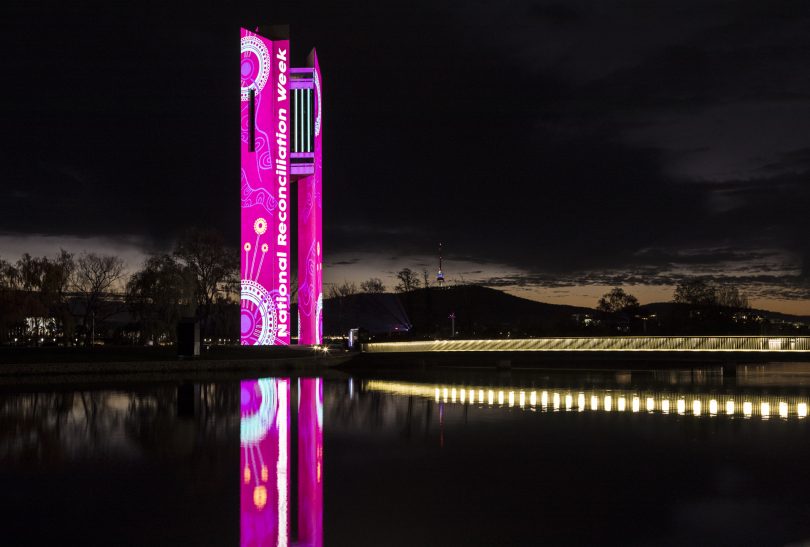
The Carillon was lit up for Reconciliation Week 2020. Photo: Michelle Kroll.
Despite protests from multiple sources, Environment Minister Sussan Ley announced before Christmas that the controversial extension to the Australian War Memorial will go ahead.
The $500 million cost of expanding an already well funded and major institution has been the subject of robust debate as critics and proponents argue over whether it’s necessary or wise.
The ANU’s Professor Mark Kenny, who gave last year’s Henry Parkes Oration at the Museum of Australian Democracy, thinks we could do better.
Rather than expanding the War Memorial, he says we need to make a permanent and significant gesture towards reconciliation with a major building or institution on the Lakeshore.
Professor Kenny used the oration to argue that Australia has a fundamental wound at its heart, a failure to talk about the truth of our origins and the dispossession and destruction of indigenous life and culture that they embody.
“Australia is more captive to its history than it realises and can’t escape injustices of the past by not talking about them”, he told Region Media after the Memorial announcement.
“Frontal recognition and accounting is vital to progress. One string to the bow of a new relationship would be a restorative grand gesture that sees the role of First Nations people on this land for tens of thousands of years before European settlement.”
Kenny says that the nature of that presence would need to be decided wholly in consultation with traditional owners and other First Nations people. It might be a shared space – a museum, a gallery, a think tank, an interpretive centre and a memorial. The space could also include a ferry wharf allowing for ceremonial arrivals.
But the location is clear: on the axis between Parliament House, Old Parliament House and the War Memorial.
“This should happen on the national axis because that’s the story of Australia and a big piece of it is missing,” he says.
“That’s why there is a poetic logic to it – it’s the primary place where you would make that point, because it’s along the institutional alignment that tells the line of our story of democracy, and a nation forged in conflict.”
Kenny says that reconciliation continues to be an uncomfortable discussion for many Australians, none more so than indigenous people for whom non-validation or repudiation of their position is an ongoing insult. But, he says, it’s fundamentally important to tell the truth about our national story, warts and all.
“I can already hear the argument from naysayers that spending money on a symbolic building misses the point and would be better directed to improving the health and education of disadvantaged Indigenous communities,” he said in the oration.
“Yet these same people are happy to be spending an obscene amount of expanding the Australian War Memorial. Here’s an idea, stop that hotly contested extravagance and put those half-a-billion dollars into addressing Indigenous disadvantage.
“Or perhaps just accept that you do value symbolism (such as the War Memorial) and then consider which is the more justified – a proper, permanent recognition of Indigenous Australia’s long-denied history, or an even grander war museum.”
Citing the likes of the Holocaust Museum in Berlin and the Yad Vashem World Holocaust Remembrance Center in Jerusalem, Kenny says that the German people have gone through a similarly complex national discussion, confronting the truths of World War II. He believes that their society is all the stronger for the honesty and self-reflection embodied in that process.
“And while we’re critiquing symbolism, ask yourself this: what does it say about a nation that will spend five or six hundred million dollars expanding the AWM when the kind of project I’m suggesting here is not even discussed?”, he said.
Kenny characterises the call as patriotic, arguing that the reconciliation issue needs to be dealt with for the betterment of all Australians. He parallels our multicultural experience with the reconciliation journey: sometimes very difficult, but valuable for our community when done overtly and well.
And, he says, making a major national gesture of reconciliation does not mean implying direct responsibility in the current generation for past wrongs.
“Reconciliation doesn’t need to be as hard as people think or fear it is,” he says.
“A centre in our national capital, in the most prominent place possible would mark the positive and negative – everything from indigenous art and culture to analysis of political struggles, dispossession, poverty and dislocation.
“All of that comes with the true story. It’s not less true by virtue of not talking about it.”
Original Article published by Genevieve Jacobs on The RiotACT.







